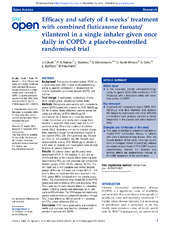| dc.contributor.author | Lotvall, J | en_US |
| dc.contributor.author | Bakke, Per S. | en_US |
| dc.contributor.author | Bjermer, Leif | en_US |
| dc.contributor.author | Steinshamn, Sigurd Loe | en_US |
| dc.contributor.author | Scott-Wilson, C | en_US |
| dc.contributor.author | Crim, Courtney | en_US |
| dc.contributor.author | Sanford, L | en_US |
| dc.contributor.author | Haumann, B | en_US |
| dc.date.accessioned | 2016-04-01T11:34:25Z | |
| dc.date.available | 2016-04-01T11:34:25Z | |
| dc.date.issued | 2012-01-19 | |
| dc.Published | BMJ Open 2012, 2(1) | eng |
| dc.identifier.issn | 2044-6055 | |
| dc.identifier.uri | https://hdl.handle.net/1956/11814 | |
| dc.description.abstract | Background. Fluticasone furoate/vilanterol (FF/VI) is a novel once-daily (OD) inhaled corticosteroid/long-acting β2 agonist combination in development for chronic obstructive pulmonary disease (COPD) and asthma. Trial design. A multicentre, randomised, double-blind, parallel-group, placebo-controlled study. Methods. Participants were patients with moderate-to-severe COPD treated with placebo or FF/VI 400/25 μg OD for 4 weeks. Study objectives were to assess the safety and efficacy of FF/VI 400/25 μg OD administered for 4 weeks via a novel dry powder inhaler. Co-primary end points were change from baseline in weighted mean (wm) heart rate 0–4 h postdose at day 28 and the incidence of adverse events (AEs). Secondary end points included change from baseline in trough forced expiratory volume in one second (FEV1) (23–24 h postdose; day 29) and wm FEV1 (0–4 h postdose; day 28). Patients were randomised to receive FF/VI 400/25 μg or placebo in a 2:1 ratio; all patients and investigators were blinded to active or placebo treatment. Results. 60 patients (mean age 64 years) were randomised (FF/VI: n=40; placebo: n=20), and all contributed data to the analysis. Mean screening post-bronchodilator FEV1 per cent predicted was comparable between groups (FF/VI: 58.5%; placebo: 60.1%). The wm heart rate 0–4 h postdose was similar between groups (difference: 0.6 beats per minute; 95% CI −3.9 to 5.1). More on-treatment AEs were reported in the FF/VI group (68%) compared with the placebo group (50%). The most common drug-related AEs in the FF/VI group were oral candidiasis (8%) and dysphonia (5%). There were no clinically relevant effects on laboratory values, including glucose and potassium, or on vital signs or ECGs/Holters. The FF/VI group had statistically greater improvements compared with placebo in trough FEV1 (mean difference 183 ml) and 0–4 h postdose wm FEV1 (mean difference 236 ml). Conclusion. FF/VI has a good safety and tolerability profile and improves lung function compared with placebo in patients with COPD. | en_US |
| dc.language.iso | eng | eng |
| dc.publisher | The BMJ (British Medical Journal Publishing Group) | eng |
| dc.rights | Attribution CC BY-NC 2.0 | eng |
| dc.rights.uri | http://creativecommons.org/licenses/by-nc/2.0/ | eng |
| dc.title | Efficacy and safety of 4 weeks' treatment with combined fluticasone furoate/vilanterol in a single inhaler given once daily in COPD: a placebo-controlled randomised trial | en_US |
| dc.type | Peer reviewed | |
| dc.type | Journal article | |
| dc.date.updated | 2015-11-10T11:28:56Z | |
| dc.description.version | publishedVersion | en_US |
| dc.identifier.doi | https://doi.org/10.1136/bmjopen-2011-000370 | |
| dc.identifier.cristin | 1024287 | |
| dc.subject.nsi | VDP::Medisinske Fag: 700 | en_US |

